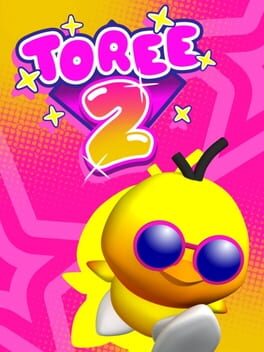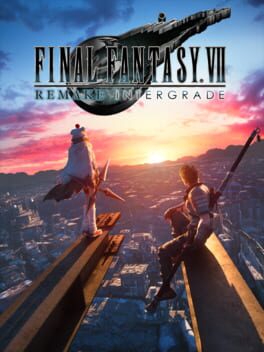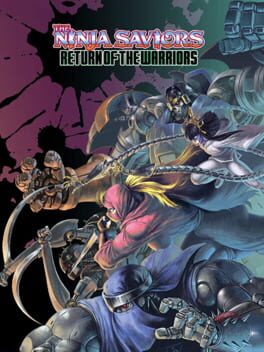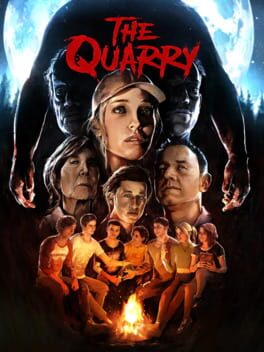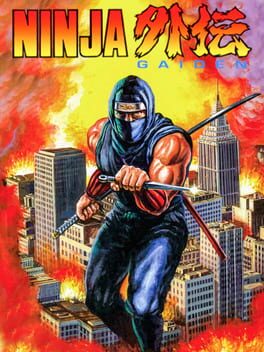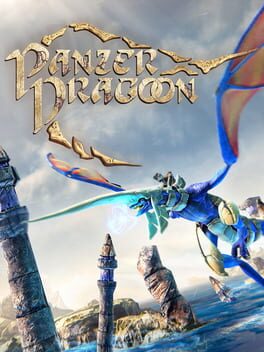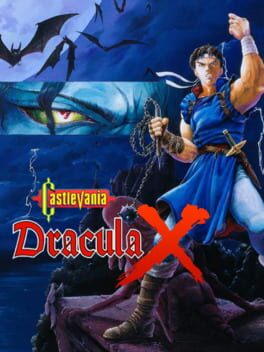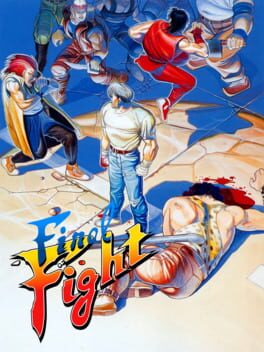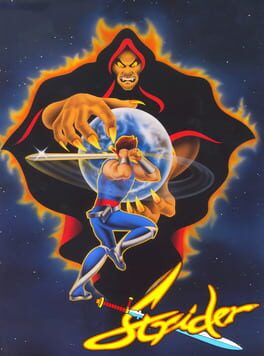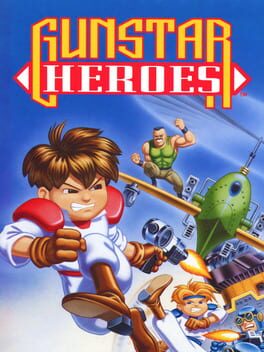ogremode
2021
Had a great time returning to FF7R. Yuffie was one of my favorite characters in the original game, and one of my main party members—she's a goofy thief who's always trying to steal from the player, but for a good cause. Her characterization in this dlc is great, reframing her as a kid who desperately has to prove herself, while trying and failing to be cool. She's also a lot of fun to play as.
Final Fantasy 7 Remake was already somewhat of a Yakuza game, and that continues here as it wisely reuses the NPCs and locations from the regular game. It looks like the next game will do the same.
I was disappointed that the limit breaks still get interrupted by cut scenes, and end early if you hit whatever the HP mark is to activate the cutscene--it really takes the air out of the combat, and feels at odds with the ATB/limit break/summon bar generation combat flow. The meticulousness of the enemy encounters call for these hard breaks, but I hope the team finds a way of not interrupting your limit breaks in the next game, even if the solution is something like enemy HP getting inflated to compensate for the extra damage done by the limit break animation. This is mostly a slick, polished experience—for me, the FF7R games represent the epitome of AAA gaming, and I'm really looking forward to the next one.
Final Fantasy 7 Remake was already somewhat of a Yakuza game, and that continues here as it wisely reuses the NPCs and locations from the regular game. It looks like the next game will do the same.
I was disappointed that the limit breaks still get interrupted by cut scenes, and end early if you hit whatever the HP mark is to activate the cutscene--it really takes the air out of the combat, and feels at odds with the ATB/limit break/summon bar generation combat flow. The meticulousness of the enemy encounters call for these hard breaks, but I hope the team finds a way of not interrupting your limit breaks in the next game, even if the solution is something like enemy HP getting inflated to compensate for the extra damage done by the limit break animation. This is mostly a slick, polished experience—for me, the FF7R games represent the epitome of AAA gaming, and I'm really looking forward to the next one.
I had a blast playing through Tengo Project's Ninja Saviors. I ran through the game mostly as Ninja, a hulking cyborg-ninja with glowing red eyes and huge metal arms. It felt like I was playing through one of those ultraviolent 90s OVAs, and I was playing as the bad guy. Like all beat em ups, there's not very much difficulty here outside of the bosses, and even the majority of those are chumps; unlike most beat em ups, the minute to minute gameplay is really fun and interesting. The different action buttons all change depending on the direction you're holding, and the context—whether you're holding an enemy, on the ground, in the air, dashing, etc. There's a ton of depth to the beating them upping, and getting a handle on your character is really rewarding. My only real complaint is that a few bosses can feel cheap, and that it's just a smidge too long for me to run through on a whim. Looking forward to dipping back into this one and playing with the other characters.
2022
I played through Supermassive Games's cinematic horror game The Quarry with my wife. We picked our characters at the start and passed the controller back and forth throughout. It was a pretty fun experience. The game is primarily "cinematic" gameplay like QTE sequences, and long cut scenes where you may make a choice or two for dialogue or the action your character takes. To break these up, there's also exploration sequences, where you can guide your character around surprisingly large spaces, though often these spaces are pretty empty. The last mode of gameplay is brief third-person shooting segments. My wife isn't a non-gamer, but she's not used to third person shooting, and she ended up fumbling at a crucial moment that led to a character's death—it was one of those rare moments of failure driven ludonarrative consonance. It really made me laugh.
Definitely a good time for a few people who like shitty teen horror movies. I do wish the option to rewind was available from the start. I'm not really interested in replaying whole sections, especially after finding out the epilogue sequence just lists who lived and who died.
Definitely a good time for a few people who like shitty teen horror movies. I do wish the option to rewind was available from the start. I'm not really interested in replaying whole sections, especially after finding out the epilogue sequence just lists who lived and who died.
1988
Ninja Gaiden can be an excellent post-Castlevania NES action game, turning up the speed just so to forge its fast identity that would carry through for decades. Where Trevor Belmont plods his way towards Dracula's castle, and his whip attacks require a comparatively long wind up, Ryu Hayabusa dashes and flips fluidly through levels and whips his katana out with lightning speed—though, crucially, not instantly. In its best moments the level design supports and drives this speed, but too often, and especially as you get deeper into the game, enemies are placed directly where you would flip into them, brutally disrupting the flow. Most of the time these obstacle enemies only spawn as you get to the edge of a platform, when, if you're playing speedily, you've already jumped, so it feels especially unfair and punishing. You're forced to pause and wait for the enemy to move over, batting away enemy hawks in the meantime; it just doesn't really feel good. But the moment to moment action outside of this is a lot of fun and feels snappy.
The bosses are more merciful experiences, tests of your patience and problem solving more than they are your pure action skills, though they can require power-ups to make them at all bearable. They're fine and satisfying, but they don't feel necessarily of one with the speed that makes the levels so fun. Looking forward to playing the sequels.
The bosses are more merciful experiences, tests of your patience and problem solving more than they are your pure action skills, though they can require power-ups to make them at all bearable. They're fine and satisfying, but they don't feel necessarily of one with the speed that makes the levels so fun. Looking forward to playing the sequels.
1985
Elevator Action Returns - S-Tribute is a rerelease of the Taito masterpiece for modern platforms, specifically of the Sega Saturn version, with the usual bells and whistles of emulated game releases like this. There's quick saves so you can put a run down and return to it later, a "slow mode" that can be activated at any time to makes the game a little easier, there's a difficulty setting, options for infinite or limited credits, and buttons are all remappable. But the release could be a little better. There's none of the fun behind the scenes stuff like concept art or box art galleries like you'll find in the Megaman or Castlevania Collections. And unfortunately there's no online version, so you cannot play with friends online, but you can do two player couch co-op.
Still, Elevator Action Returns is one of the beautiful action arcade games. It improves on the original by bringing using mechanics from Namco's Rolling Thunder, the side-scrolling arcade shooting/cover game. Enemies spawn from doors. Both you and enemies can crouch; weapons are fired on either the high or low axis, and you can avoid damage by ducking under or jumping over bullets, or taking cover (though most cover will degrade after a few hits). The goal of the game is to fight your way to every red door in a level, then get to the end of the level to escape. There are security cameras which, if you don't shoot in time, will spawn more enemies. The game will take about an hour or so per play-through, with infinite credits, depending on how often you die, but it's such a blast all the way through.
You can play as one of three characters, and swap between them on the fly when you run out of lives and have to put in a credit. There's Kart Bradfield, who is the most agile and has a hand grenade as his subweapon. There's Edie Burret, who has the fire bomb subweapon and more importantly can fire bullets very quickly. Then there's Jad the Taff, who's very tough and has a proximity bomb subweapon.
There are a handful of set-pieces in each level—exploding planes your character escapes from, collapsing buildings, and so on, which break up the games pace a bit and are always cool as hell and well-animated. The art style is also just sick as hell 90s anime inspired pixel art. It's a real blast to play through, and I hope one day I get to play it on a cabinet.
GOTY 2022.
Still, Elevator Action Returns is one of the beautiful action arcade games. It improves on the original by bringing using mechanics from Namco's Rolling Thunder, the side-scrolling arcade shooting/cover game. Enemies spawn from doors. Both you and enemies can crouch; weapons are fired on either the high or low axis, and you can avoid damage by ducking under or jumping over bullets, or taking cover (though most cover will degrade after a few hits). The goal of the game is to fight your way to every red door in a level, then get to the end of the level to escape. There are security cameras which, if you don't shoot in time, will spawn more enemies. The game will take about an hour or so per play-through, with infinite credits, depending on how often you die, but it's such a blast all the way through.
You can play as one of three characters, and swap between them on the fly when you run out of lives and have to put in a credit. There's Kart Bradfield, who is the most agile and has a hand grenade as his subweapon. There's Edie Burret, who has the fire bomb subweapon and more importantly can fire bullets very quickly. Then there's Jad the Taff, who's very tough and has a proximity bomb subweapon.
There are a handful of set-pieces in each level—exploding planes your character escapes from, collapsing buildings, and so on, which break up the games pace a bit and are always cool as hell and well-animated. The art style is also just sick as hell 90s anime inspired pixel art. It's a real blast to play through, and I hope one day I get to play it on a cabinet.
GOTY 2022.
2022
This is the first game I've played directed by Sam Barlow. I had a good time exploring this game. The story itself is interesting enough, but it does feel a lot like a guy who is really into David Lynch decidedly making something in the Lynch vein but getting too into the details of the supernatural stuff; which is to say the story works on its own, but that it invites comparisons it just can't win. Granted, that's true for most narrative games. Disco Elysium isn't much different, or necessarily better, than dozens of detective novels; Pentiment is a hair away from being an adaptation of Umberto Eco's The Name of the Rose. That doesn't take anything away from them being excellent games.
The reason we go to narrative games is because they are games, not because of the narrative, and the game to this one is fascinating. You navigate through the clips—and so, through the story—by clicking on an object on the screen: an actor, a painting, a fruit, a light; there's a shocking amount of variety on what you can click on to move forward. You are then sent to a different clip through a match-cut. You click on a candle in one scene and then are sent to a candle in a different scene; there's a digital zoom out from the candle in the new scene, and then the clip continues to play from there. You learn eventually that you should rewind to the beginning of the clip to see the whole thing. Your navigation through the clips is semi-random, meaning that you will bounce around until you're sent to specific clips at certain times to further the main story. The journey through the story is unique for each play through; it's a radical version of post-modern, non-linear story-telling, like if the different stories in Pulp Fiction were twice as long and played on shuffle. The narrative peels open this way, and that itself is fascinating alone.
It isn't just that you jump to a scene watch it, pick something, and then watch another scene either. You can't really put the controller down and look at your phone; you're forced to pay attention to the narrative. In the age of streaming, this is an interesting innovation in itself (and maybe streaming shows would be better if the creators knew for certain you would pay total attention to them). You can't put down the controller because there are secret clips. Your controller vibrates, there's usually a distinctive eerie audio cue, and you have to manually rewind at the correct speed to push the secret scene open. If you miss the cue (or, like me, wonder "what the hell was that" when it happens the first couple times) the scenes with secret scenes in them will have a glowing background on the clip view. The speed you have to rewind is different usually; sometimes you have to turn your stick slowly, sometimes it helps to fast rewind. There isn't a lot of feedback for this action though, and for some scenes I had a lot of trouble getting them to play. This difficulty didn't seem contingent on the content of the scene either; it wasn't necessarily that the scenes that were harder to open had more rewarding story or character information. I could have used some stronger feedback, but that's the only major criticism I had to the game-play.
As to the story itself and the various films, I was never super into it. Like I said before, it invites comparisons it can't handle, and the production of everything is way too clean, so it comes off ahistorical looking, something that won't really bother you if you're not like me. There's a layer of theatrical unreality that doesn't work in its favor; the movie scenes don't feel like scenes shot for a movie, but scenes shot for a fake movie video game. But it's fun and can be interesting; the novelty was enough to drive me forward with this one. I was left pretty interested in checking out Barlow's other games.
The reason we go to narrative games is because they are games, not because of the narrative, and the game to this one is fascinating. You navigate through the clips—and so, through the story—by clicking on an object on the screen: an actor, a painting, a fruit, a light; there's a shocking amount of variety on what you can click on to move forward. You are then sent to a different clip through a match-cut. You click on a candle in one scene and then are sent to a candle in a different scene; there's a digital zoom out from the candle in the new scene, and then the clip continues to play from there. You learn eventually that you should rewind to the beginning of the clip to see the whole thing. Your navigation through the clips is semi-random, meaning that you will bounce around until you're sent to specific clips at certain times to further the main story. The journey through the story is unique for each play through; it's a radical version of post-modern, non-linear story-telling, like if the different stories in Pulp Fiction were twice as long and played on shuffle. The narrative peels open this way, and that itself is fascinating alone.
It isn't just that you jump to a scene watch it, pick something, and then watch another scene either. You can't really put the controller down and look at your phone; you're forced to pay attention to the narrative. In the age of streaming, this is an interesting innovation in itself (and maybe streaming shows would be better if the creators knew for certain you would pay total attention to them). You can't put down the controller because there are secret clips. Your controller vibrates, there's usually a distinctive eerie audio cue, and you have to manually rewind at the correct speed to push the secret scene open. If you miss the cue (or, like me, wonder "what the hell was that" when it happens the first couple times) the scenes with secret scenes in them will have a glowing background on the clip view. The speed you have to rewind is different usually; sometimes you have to turn your stick slowly, sometimes it helps to fast rewind. There isn't a lot of feedback for this action though, and for some scenes I had a lot of trouble getting them to play. This difficulty didn't seem contingent on the content of the scene either; it wasn't necessarily that the scenes that were harder to open had more rewarding story or character information. I could have used some stronger feedback, but that's the only major criticism I had to the game-play.
As to the story itself and the various films, I was never super into it. Like I said before, it invites comparisons it can't handle, and the production of everything is way too clean, so it comes off ahistorical looking, something that won't really bother you if you're not like me. There's a layer of theatrical unreality that doesn't work in its favor; the movie scenes don't feel like scenes shot for a movie, but scenes shot for a fake movie video game. But it's fun and can be interesting; the novelty was enough to drive me forward with this one. I was left pretty interested in checking out Barlow's other games.
This SNES version of Rondo of Blood isn't a completely bad Castlevania game, but it comes off limited in comparison. Controls wise it's a step back from Super Castlevania IV—you only have the horizontal whip attack, though you can backflip which is very fun to pull off in spotty situations. There's no whip swinging, no diagonal or vertical whip attacks, no alternate paths, and the levels are basic and not as well-designed as usual. It feels like there's an overuse of the Spear Guard—maybe I just don't know how to fight them, but Richter's reach is too short and his animation is too slow to get a hit in and get out without getting hit. Often when climbing stairs an enemy will stand at the end, and without a diagonal whip attack there's nothing to do but walk up the stairs to take damage; it especially sticks out compared to the earlier games because while they can be difficult and unfair, they usually aren't this cheap. This is all compounded by the fact that some enemies take a lot more damage than usual to kill them—in the best scenario, it feels like you're having a duel with a Sword Lord or Axe Knight, but it can also feel tedious and unfair when you're dealing with platforming or Bats/Medusa Head at the same time. Still, I'm a sucker for the basic Castlevania experience so I mostly had a good with the levels.
The bosses at the end of the levels are mostly pretty good versions of them. The exception is the Count himself, who is here in his most annoying version. It's the typical dodge projectile + attack head thing, but rather than a regular arena, the level is a set of pillars floating at various heights, and Dracula teleports to a random one before each attack. This makes jumping just right to dodge and hit his head very difficult—the timing is a lot more precise than usual. You can't simply jump over the projectile then attack because Richter doesn't have that much height and speed to jump from a lower place when Dracula attacks. You can't attack the projectile then jump and attack because you typically would need to jump to hit the projectile; once Richter lands, you don't have enough time to jump again and hit Dracula's head before the window closes. Dracula will also throw an energy ball, which can only be dodged by jumping or backflipping over it, depending on the height of the attack, or by getting to the lowest pillar and crouching so it glides right over you. On top of all this Richter has a momentum and weight to his jumps, and you cannot guide Richter after you've already hit the jump button, so it is extremely easy to fall to your death, or land your jump on the pillar only to slide to your death. It's very frustrating, but with rewind + save states it just becomes very tedious. The second phase where Dracula goes demon mode is a lot easier. His projectiles have an easier timing and placement so you can often take out the projectiles and get damage in at the same time, and you can jump through or crouch to dodge his wind hoop attack.
The best part of the game, besides timing a backflip perfectly, is the way it looks. It's more artistic/anime looking than the blocky classic style of Rondo of Blood, and actually looks a little slicker to me than Symphony of the Night; it's much closer to the GBA games that Dracula X is now packaged with. The music is good too, though nothing stuck out for me.
Altogether this is an unfortunately middling game that makes me appreciate Super Castlevania IV and Castlevania: Bloodlines even more. Until Konami releases a Rondo collection on something besides PlayStation, this will have to do.
The bosses at the end of the levels are mostly pretty good versions of them. The exception is the Count himself, who is here in his most annoying version. It's the typical dodge projectile + attack head thing, but rather than a regular arena, the level is a set of pillars floating at various heights, and Dracula teleports to a random one before each attack. This makes jumping just right to dodge and hit his head very difficult—the timing is a lot more precise than usual. You can't simply jump over the projectile then attack because Richter doesn't have that much height and speed to jump from a lower place when Dracula attacks. You can't attack the projectile then jump and attack because you typically would need to jump to hit the projectile; once Richter lands, you don't have enough time to jump again and hit Dracula's head before the window closes. Dracula will also throw an energy ball, which can only be dodged by jumping or backflipping over it, depending on the height of the attack, or by getting to the lowest pillar and crouching so it glides right over you. On top of all this Richter has a momentum and weight to his jumps, and you cannot guide Richter after you've already hit the jump button, so it is extremely easy to fall to your death, or land your jump on the pillar only to slide to your death. It's very frustrating, but with rewind + save states it just becomes very tedious. The second phase where Dracula goes demon mode is a lot easier. His projectiles have an easier timing and placement so you can often take out the projectiles and get damage in at the same time, and you can jump through or crouch to dodge his wind hoop attack.
The best part of the game, besides timing a backflip perfectly, is the way it looks. It's more artistic/anime looking than the blocky classic style of Rondo of Blood, and actually looks a little slicker to me than Symphony of the Night; it's much closer to the GBA games that Dracula X is now packaged with. The music is good too, though nothing stuck out for me.
Altogether this is an unfortunately middling game that makes me appreciate Super Castlevania IV and Castlevania: Bloodlines even more. Until Konami releases a Rondo collection on something besides PlayStation, this will have to do.
1988
I played the PCE version, making heavy use of the rewind feature of Retroarch. Really wildly difficult, and gets in its own way. Has a B-Wing style upgrade system. The art is pretty bland. Cannot recommend this one for basically any reason.
1989
Final Fight isn't the first "beat them up" game, but it's the moment the genre became tolerable, and it can even reach heights of fun. I played through the game using all the characters, but my favorite was the huge Mike Haggar. The characters all play slightly differently, and have different special moves. I don't like that the special moves burn health to use them—the idea is that they should become tactical, but the moveset is somewhat limited, so I found myself using the special moves pretty often. I'm also not good at this game whatsoever, but the game doesn't make me want to get good at it.
Enemy types that appear in God Hand
- Cars
- Knife throwers
- Women that jump around like ninjas
- Homophobia
- Fat guys
- Andre the Giant looking guys
Enemy types that appear in God Hand
- Cars
- Knife throwers
- Women that jump around like ninjas
- Homophobia
- Fat guys
- Andre the Giant looking guys
1991
An SNES upgrade of the original Castlevania with more movement and attack abilities. The former feels particularly necessary, kind of like the plunging attack in Dark Souls—you don't realize how much you miss it, and you're in for a really rude awakening playing the original and discovering you can't land a jump on stairs, which is like muscle memory for me at this point, or in Demons Souls finding yourself in the middle of a group of enemies you thought you had the literal jump on. The whip spinning is really useful for certain enemies, and it's just fun to whip that thing around, but it doesn't feel exactly as necessary as the multi-directional whip attack.
I tend to prefer the simpler Castlevania games, so I had a blast with this one. No character switching, no back tracking. Just pressing right to watch megachad Simon amble towards Dracula's castle like Michael Myers with a whip. It's challenging, and some of the difficulty can feel like bullshit. But I have no qualms about using save states to alleviate this.
I really liked the soundtrack of this one, particularly 7-1 and 8-1 (so chill), and how during the Dracula fight it switches from the tense Carpenterian synth to Simon's theme when the Count is on his last legs.
I tend to prefer the simpler Castlevania games, so I had a blast with this one. No character switching, no back tracking. Just pressing right to watch megachad Simon amble towards Dracula's castle like Michael Myers with a whip. It's challenging, and some of the difficulty can feel like bullshit. But I have no qualms about using save states to alleviate this.
I really liked the soundtrack of this one, particularly 7-1 and 8-1 (so chill), and how during the Dracula fight it switches from the tense Carpenterian synth to Simon's theme when the Count is on his last legs.
1989
Strider is a cool looking action game—the sprites and backgrounds are excellent, and Strider's animations as he flips or attacks looks cool as hell. However he doesn't feel as agile as he looks—it can feel a little awkward handling him. The way you run through levels while things explode around you reminded me a bit of Gunstar Heroes, and the way Strider builds momentum when running down hills felt a lot like playing the first Sonic game. Like most arcade games the challenge here is a combination of skill based action and memorizing when and where enemies are, and where to go; the most frustrated I felt playing this game was at the end of one of the levels, where you have to jump on a floating ship in the right-hand corner of the map. It just isn't well communicated.
Really worth playing though, it's an interesting and novel arcade game, even if it doesn't completely work.
Really worth playing though, it's an interesting and novel arcade game, even if it doesn't completely work.
1993
